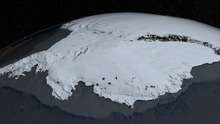Geology of Antarctica



The geological history of Antarctica covers the geological development of the continent through the Proterozoic Eon, Paleozoic, Mesozoic and Cenozoic eras.
More than 170 million years ago, Antarctica was part of the supercontinent Gondwana. Over time Gondwana broke apart and Antarctica as we know it today was formed around 35 million years ago.
Proterozoic Eon
The Mawson craton of East Antarctica and Australia preserves evidence of tectonic activity from the Archean through the Mesoproterozoic in the Terre Adelie, King George V Land and the Miller Range of the central Transantarctic Mountains.[1]
Paleozoic Era (540–250 Ma)
During the Cambrian period, Gondwana had a mild climate. West Antarctica was partially in the northern hemisphere, and during this period large amounts of sandstones, limestones and shales were deposited. East Antarctica was at the equator, where sea-floor invertebrates and trilobites flourished in the tropical seas. By the start of the Devonian period (416 Ma) Gondwana was in more southern latitudes and the climate was cooler, though fossils of land plants are known from this time. Sand and silts were laid down in what is now the Ellsworth, Horlick and Pensacola Mountains. Glaciation began at the end of the Devonian period (360 Ma) as Gondwana became centered on the South Pole and the climate cooled, though flora remained. During the Permian period the plant life became dominated by fern-like plants such as Glossopteris, which grew in swamps. Over time these swamps became deposits of coal in the Transantarctic Mountains. Towards the end of the Permian period continued warming led to a dry, hot climate over much of Gondwana.[2]
Mesozoic Era (250–66 Ma)
As a result of continued warming, the polar ice caps melted and much of Gondwana became a desert. In East Antarctica the seed fern became established, and large amounts of sandstone and shale were laid down at this time. The Antarctic Peninsula began to form during the Jurassic period (206–146 Ma), and islands gradually rose out of the ocean. Ginkgo trees and cycads were plentiful during this period, as were reptiles such as Lystrosaurus. In West Antarctica conifer forests dominated through the entire Cretaceous period (146–65 Ma), though Southern beech began to take over at the end of this period. Ammonites were common in the seas around Antarctica, and dinosaurs were also present, though only three Antarctic dinosaur genera (in order of naming, Cryolophosaurus, Antarctopelta, and Glacialisaurus) have been described to date. It was during this period that Gondwana began to break up.
Geology of present-day Antarctica
The geological study of Antarctica has been greatly hindered by the fact that nearly all of the continent is continuously covered with a thick layer of ice. However, new techniques such as remote sensing have begun to reveal the structures beneath the ice.
Geologically, West Antarctica closely resembles the Andes of South America.[2] The Antarctic Peninsula was formed by uplift and metamorphism of sea-bed sediments during the late Paleozoic and the early Mesozoic eras. This sediment uplift was accompanied by igneous intrusions and volcanism. The most common rocks in West Antarctica are andesite and rhyolite volcanics formed during the Jurassic Period. There is also evidence of volcanic activity, even after the ice sheet had formed, in Marie Byrd Land and Alexander Island. The only anomalous area of West Antarctica is the Ellsworth Mountains region, where the stratigraphy is more similar to the eastern part of the continent.
The West Antarctic Rift, a major active rift valley, lies between West and East Antarctica. The rift is still active with slow movement of West Antarctica away from East Antarctica.
East Antarctica is geologically very old, dating from the Precambrian, with some rocks formed more than 3 billion years ago. It is composed of a metamorphic and igneous platform which is the basis of the continental shield. On top of this base are various more modern rocks, such as sandstones, limestones, coal and shales laid down during the Devonian and Jurassic periods to form the Transantarctic Mountains. In coastal areas such as Shackleton Range and Victoria Land some faulting has occurred.
The main mineral resource known on the continent is coal. It was first recorded near the Beardmore Glacier by Frank Wild on the Nimrod Expedition, and now low-grade coal is known across many parts of the Transantarctic Mountains. The Prince Charles Mountains contain significant deposits of iron ore. The most valuable resources of Antarctica lie offshore, namely the oil and natural gas fields found in the Ross Sea in 1973. Exploitation of all mineral resources by signatory states is banned until 2048 by the Protocol on Environmental Protection to the Antarctic Treaty.
See also
References
- ↑ Fitzsimmons, I. C. W., Proterozoix Basement Provinces of Southern and Southwestern Australia, and There Correlation with Antarctica, pp 93-130 in Masaru Yoshida, M., B. F. Windley and S. Dasgupta (eds), Proterozoic East Gondwana: Supercontinent Assembly and Breakup, Geological Society of London, Special Publication No. 206, 2003 ISBN 978-1862391253
- 1 2 Stonehouse, B. (ed.), ed. (June 2002). Encyclopedia of Antarctica and the Southern Oceans. John Wiley & Sons. ISBN 0-471-98665-8.
.svg.png)